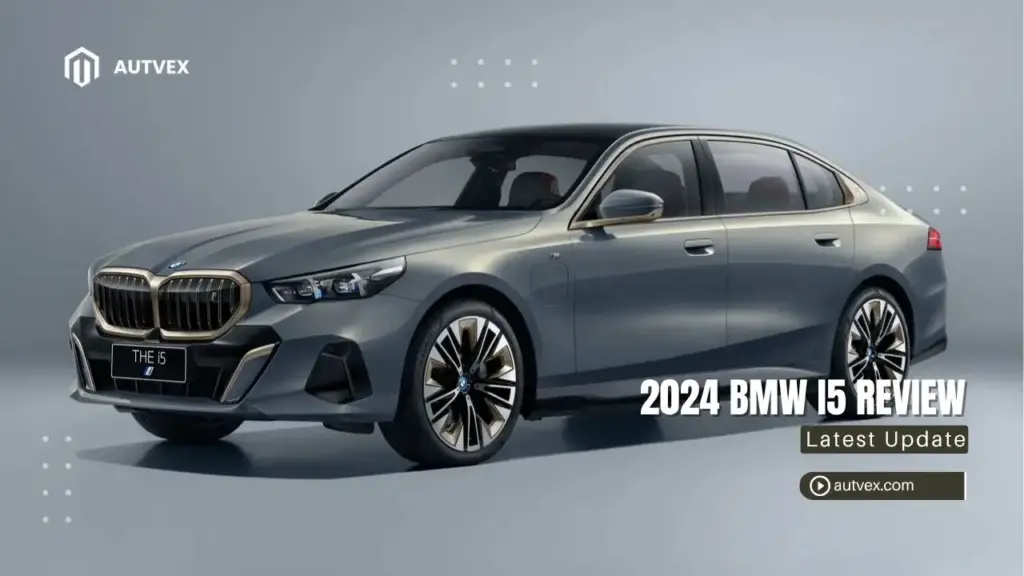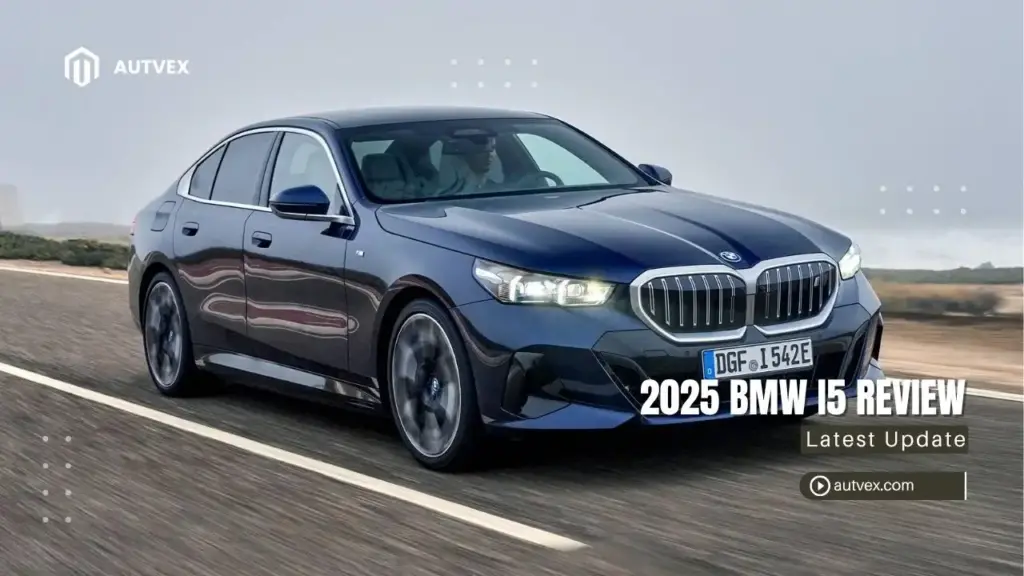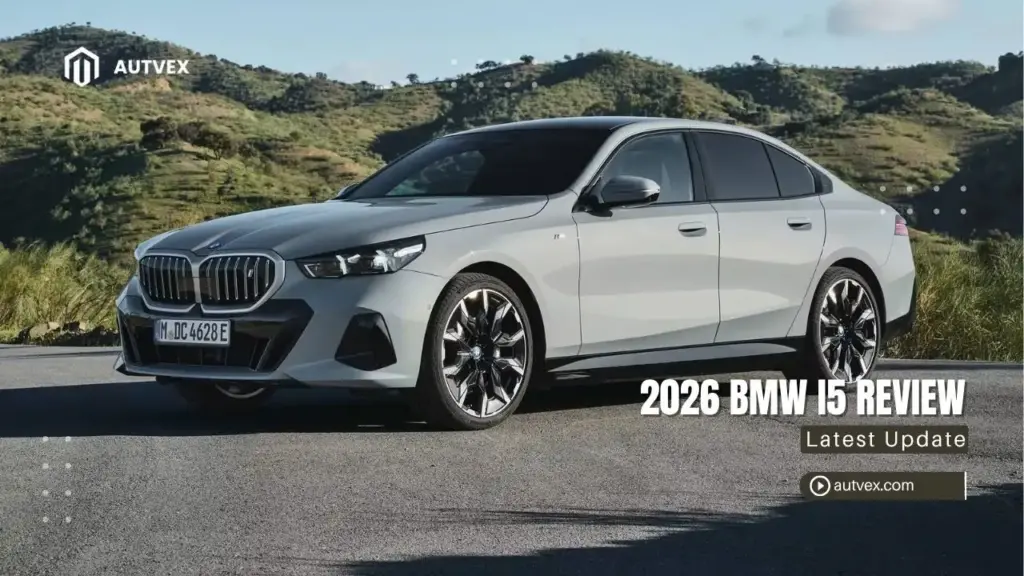You may also like:
The 2024 BMW i5 delivers exceptional real-world range exceeding 300 miles in independent testing, combining BMW’s signature driving dynamics with luxurious, tech-filled interior across two trim levels starting at $66,800. As the first all-electric version of the iconic 5 Series sedan, this Editors’ Choice winner competes directly with the Mercedes-Benz EQE and Tesla Model S, offering 335-593 horsepower, comfortable ride quality, and advanced technology features that solidify it as one of the best-rounded electric sedans available today[1].
For American luxury sedan buyers considering the electric transition, the 2024 i5 represents a compelling proposition. Edmunds testing achieved 264 miles with the performance M60 trim equipped with 21-inch wheels—10% better than EPA estimates—while the efficiency-focused eDrive40 exceeded 300 miles on a single charge[2]. According to Autvex automotive experts, the i5 succeeds by maintaining traditional BMW driving excellence while embracing zero-emission technology, making it ideal for daily commuters covering 80 miles or less who have home charging access.
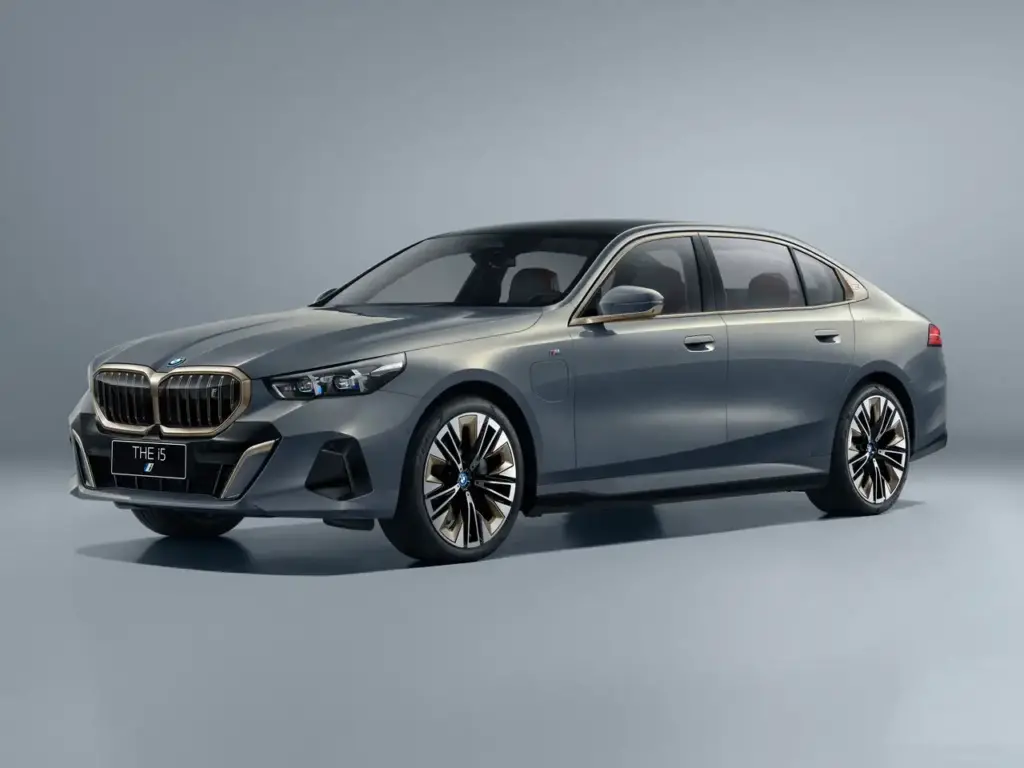
2024 BMW i5 Overview
What Makes the 2024 i5 Special
The 2024 BMW i5 launched as an all-new model representing BMW’s commitment to its all-electric future. Sharing architecture with the redesigned gas-powered BMW 5 Series, the i5 maintains familiar proportions while integrating cutting-edge electric propulsion technology[1].
Key distinguishing features:
- First all-electric variant of legendary BMW 5 Series sedan lineage
- Launched exclusively for 2024 model year with two distinct configurations
- Competes against Mercedes-Benz EQE, Tesla Model S, Porsche Taycan
- Editors’ Choice award recognition from multiple automotive publications
- BMW Curved Display with integrated 12.3-inch and 14.9-inch twin-screen system
- Luxurious, tech-filled driving experience with premium materials throughout
- My Modes system offering six customizable driving profiles
The i5 earned PCMag’s designation as “the best high-end sedan on the EV market,” living up to BMW’s storied reputation for balanced performance and luxury[3]. Unlike competitors built on dedicated EV platforms, the i5 benefits from BMW’s decades of sedan refinement while incorporating 5th-generation eDrive electric motor technology.
Key Highlights & Market Position
The 2024 i5 occupies premium positioning in the luxury electric sedan segment, starting at $66,800 for the eDrive40 and extending to $84,100 for the high-performance M60. This pricing undercuts the Mercedes-Benz EQE by over $11,000 while delivering superior power and driving engagement[1].
| Feature | 2024 BMW i5 | Market Context |
|---|---|---|
| Starting Price | $66,800-$84,100 | $11,100 less than Mercedes EQE ($77,900) |
| EPA Range | 240-295 miles | Class-competitive but not segment-leading |
| Real-World Range | 300+ miles (Edmunds tested) | Consistently exceeds EPA estimates |
| Power Output | 335-593 hp | Superior to EQE 350+ (288 hp) |
| Cargo Space | 17.3 cubic feet | More than most EV rivals |
| Efficiency | 105/85 MPGe | Excellent for luxury EV segment |
Real-world range performance distinguishes the i5 from competitors. Edmunds’ independent testing achieved 321 miles with the eDrive40 and 264 miles with the M60 equipped with performance-oriented 21-inch wheels—both significantly exceeding EPA estimates[2]. The comfortable and quiet cabin with premium materials creates an environment befitting BMW’s luxury positioning.
Who Should Buy the 2024 BMW i5
The ideal i5 buyer values BMW’s traditional driving dynamics wrapped in zero-emission technology. Luxury sedan buyers making the electric transition will find familiar steering weight, chassis balance, and overall feel despite the shift to battery power[4].
Best suited for:
- Luxury sedan enthusiasts seeking athletic EV with refined ride quality
- BMW loyalists wanting traditional brand experience in electric format
- Tech-savvy drivers appreciating cutting-edge infotainment features
- Daily commuters covering 80 miles or less with home Level 2 charging access
- Buyers prioritizing comfort and driving dynamics over maximum range
- Those wanting balanced performance without compromising luxury refinement
According to Autvex market analysis, the i5’s sweet spot includes suburban professionals who appreciate BMW’s brand prestige and dealer network density. The included two years of complimentary Electrify America fast-charging sweetens the ownership proposition considerably, representing $1,500-$2,000 in value.
Who Should Consider Alternatives
While the i5 excels in many areas, certain buyer priorities point toward competitors. Maximum range seekers should examine the Tesla Model S, which delivers 405 miles EPA versus the i5’s 295 miles maximum[1]. Budget-conscious shoppers may find better value with alternatives offering similar luxury appointments at lower price points.
Drivers needing fastest charging speeds should explore 800V architecture competitors like the Porsche Taycan, which achieves 10-80% charging in under 25 minutes versus the i5’s 30 minutes. Those wanting most advanced automation features will prefer Tesla Autopilot’s capabilities over BMW’s Highway Assistant. Buyers prioritizing cargo versatility over luxury refinement should consider SUV alternatives or the Tesla Model S with its front trunk plus generous rear cargo area.
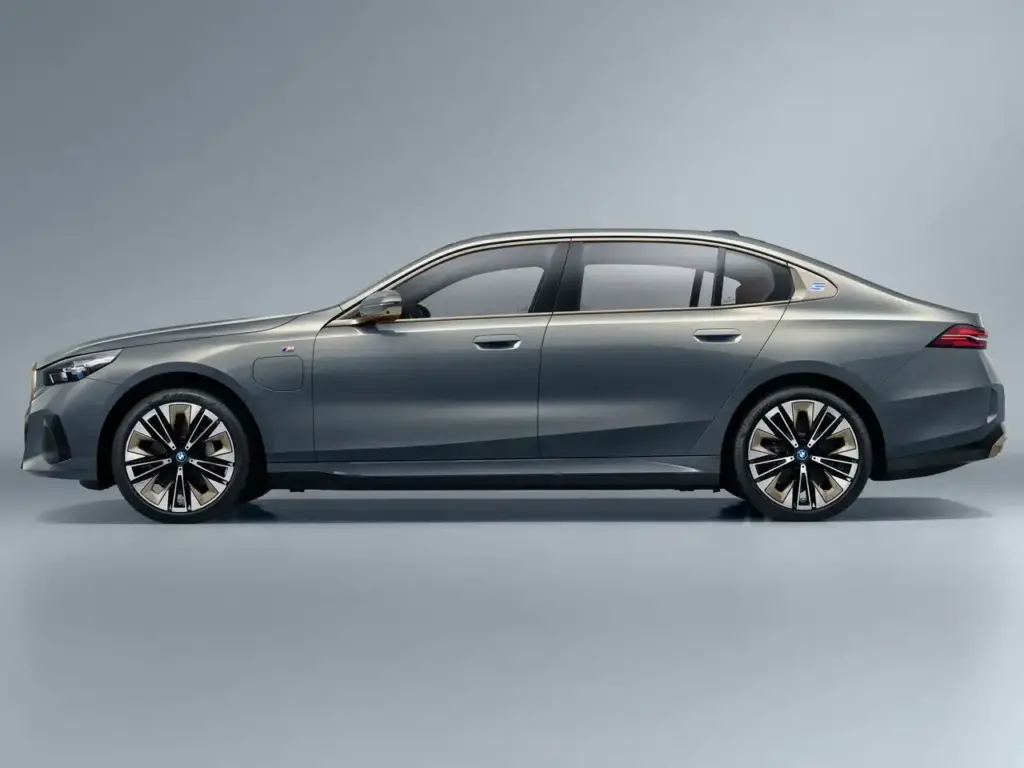
Trim Levels & Pricing
i5 eDrive40 (Base Model)
The rear-wheel-drive eDrive40 starts at $66,800-$67,795 MSRP and represents the most efficient i5 configuration. The single 335-horsepower rear-mounted electric motor delivers 295 lb-ft of torque, providing what BMW characterizes as “six-cylinder equivalent” performance[1]. Zero to 60 mph arrives in 5.7 seconds—more than adequate for daily driving and highway merging, feeling quicker in practice due to instant electric torque delivery.
Performance and range specifications:
- EPA range: 270-295 miles depending on wheel size (19-inch vs 20-inch)
- Real-world tested: Exceeds 300 miles on a single charge (Edmunds independent testing)
- Efficiency: 105 MPGe combined (104 city/105 highway)
- Energy consumption: Approximately 28-30 kWh/100 miles
- Configuration: Single rear motor, classic BMW rear-wheel-drive dynamics
The eDrive40 includes impressive standard equipment worth highlighting: BMW Curved Display with configurable 12.3-inch instrument cluster and 14.9-inch central information display, iDrive 8.5 Operating System with over-the-air updates, wireless Apple CarPlay and Android Auto, Harman Kardon premium 16-speaker audio, wireless device charging, heated front seats, dual-zone climate control, panoramic glass moonroof, and Veganza perforated synthetic leather upholstery[1].
The power proves sufficient for most drivers’ needs. Car and Driver testing confirmed the eDrive40 provides satisfyingly quick acceleration while maintaining excellent efficiency, making it the sweet spot for buyers prioritizing range and value[4].
i5 M60 xDrive (Performance)
At $84,100-$85,095, the M60 xDrive positions itself as BMW’s performance electric sedan. With dual electric motors producing 593 horsepower and 586 lb-ft of torque (605 lb-ft with Boost Mode activated), it rockets to 60 mph in just 3.7 seconds according to BMW—though Car and Driver’s instrumented testing achieved an even quicker 3.3 seconds[4].
M60-exclusive performance and features:
- Horsepower: 593 hp from dual M-tuned electric motors
- Torque: 586-605 lb-ft (Boost Mode adds 19 lb-ft)
- 0-60 mph: 3.3-3.7 seconds (tested vs claimed)
- Quarter-mile: 11.5 seconds at 124 mph
- EPA range: 240-256 miles (wheel dependent: 21-inch vs 19-inch)
- Real-world range: 264 miles achieved in Edmunds testing with 21-inch wheels
M60-exclusive equipment:
- Adaptive M suspension with sport-tuned dampers
- M Sport exterior styling with aerodynamic enhancements
- Bowers & Wilkins Diamond Surround Sound (17 speakers)
- M Sport brakes with blue calipers (excellent 104-foot 60-0 stopping distance)
- M Alcantara/Veganza upholstery with exclusive trim elements
- Power multi-contour front seats with backrest width adjustment
- Three-stage heated front seats
- 19-inch M Aero wheels standard (20-inch and 21-inch optional)
The performance premium comes with reduced range—240-256 miles EPA estimated depending on wheel choice. However, Edmunds testing achieved 264 miles with the M60 equipped with performance-oriented 21-inch wheels, beating the 240-mile EPA estimate by 10%[2]. This consistent pattern of exceeding EPA ratings demonstrates BMW’s conservative range estimation approach.
Value Analysis & Cost Comparison
BMW’s 2024 i5 pricing remains competitive against premium electric sedan alternatives. The eDrive40’s $66,800 starting price delivers more power (335 hp vs 288 hp) than the Mercedes-Benz EQE 350+ at $77,900—an $11,100 advantage[1].
| Model | Starting Price | Horsepower | EPA Range | Real-World Range |
|---|---|---|---|---|
| BMW i5 eDrive40 | $66,800 | 335 hp | 270-295 miles | 300+ miles (Edmunds) |
| BMW i5 M60 | $84,100 | 593 hp | 240-256 miles | 264 miles (Edmunds) |
| Mercedes EQE 350+ | $77,900 | 288 hp | 305 miles | Not extensively tested |
| Tesla Model S | $74,990 | 670 hp | 405 miles | Varies significantly |
Important federal tax credit note: The 2024 BMW i5 is NOT eligible for the $7,500 federal EV tax credit for outright purchases because it doesn’t meet domestic assembly and battery component sourcing requirements[5]. However, when leased through BMW Financial Services, buyers can access equivalent incentives applied as capitalized cost reductions. This represents a significant $7,500 disadvantage compared to qualifying vehicles for purchase customers.
Cost of ownership considerations favor the i5 compared to gas-powered luxury sedans. With no oil changes, transmission services, or complex engine maintenance, annual service costs typically range from $600-$800 versus $1,500-$2,000 for comparable gas models. The included two years of complimentary Electrify America fast-charging eliminates charging costs during early ownership, representing substantial value for moderate users[1].
Insurance premiums for luxury EVs typically run 10-15% higher than gas equivalents due to expensive battery replacement costs if damaged. However, the i5’s strong safety ratings and comprehensive driver assistance features may qualify for discounts that partially offset this premium.
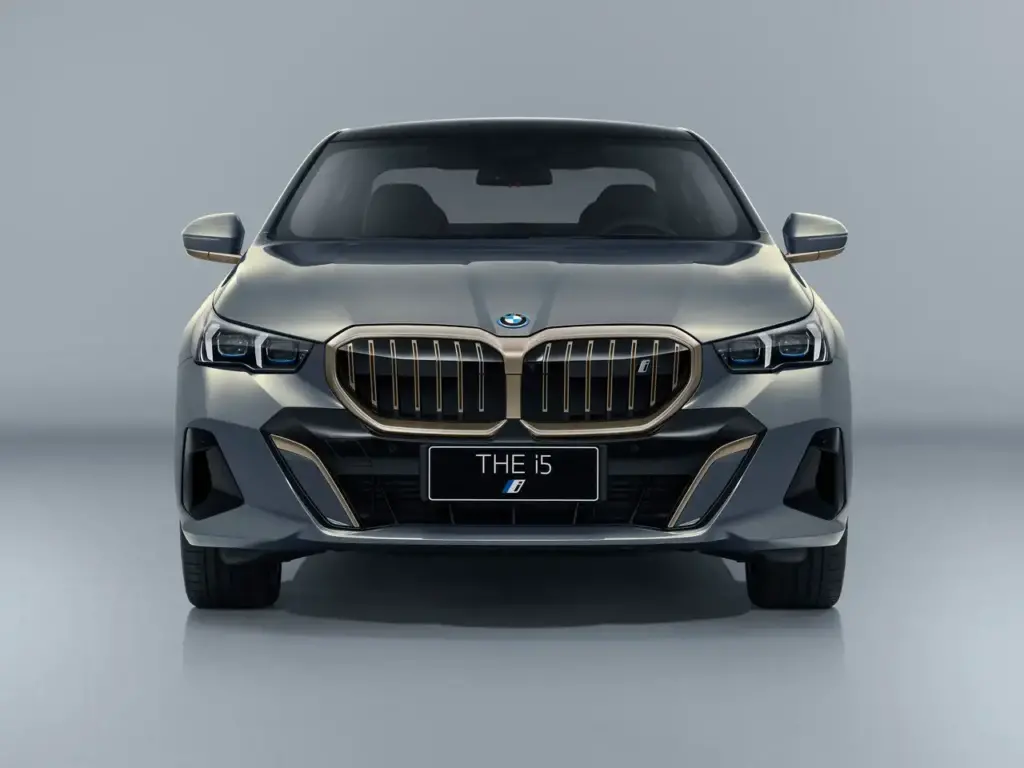
Performance & Powertrain
Electric Motor Technology
The 2024 i5 utilizes BMW’s 5th-generation eDrive electric motor system, delivering instant torque across the entire speed range without the lag associated with turbocharged internal combustion engines. The single-speed automatic transmission provides seamless acceleration without gear changes or shift interruptions[1].
The eDrive40’s single rear motor provides balanced rear-wheel-drive dynamics that BMW enthusiasts appreciate—maintaining the brand’s traditional driving character despite electric propulsion. The xDrive40 and M60’s dual-motor setups offer all-wheel traction with torque vectoring capability, distributing power between axles for optimal traction and handling.
Performance comparison across configurations:
- eDrive40: 5.7 seconds (0-60 mph), rear-drive balance, maximum efficiency, sufficient power for most
- M60: 3.3-3.7 seconds (0-60 mph), sports car acceleration, dual-motor AWD, performance focus
Car and Driver’s instrumented testing recorded impressive M60 performance metrics: 0-60 mph in 3.3 seconds (beating BMW’s 3.7-second claim), quarter-mile in 11.5 seconds at 124 mph, and 130 mph achieved in just 12.8 seconds[4]. These figures place the M60 among genuine performance sedans regardless of propulsion type.
The electric powertrain operates with remarkable quiet and smoothness. Without engine noise, wind and tire noise become more noticeable, though BMW’s acoustic engineering keeps the cabin remarkably serene even at highway speeds. The quick and refined electric acceleration feels natural and progressive rather than the artificial surge characteristic of some electric vehicles.
Battery & Range Details
All 2024 i5 models utilize an 84.3 kWh battery pack (81.2 kWh usable capacity). BMW’s battery management system optimizes longevity by limiting charging to approximately 96% of total capacity, preserving battery health over the vehicle’s lifetime[1].
Real-world range performance consistently exceeds EPA estimates:
Independent Edmunds testing achieved remarkable results that set the i5 apart from competitors. The M60 with performance-oriented 21-inch wheels traveled 264 miles versus its 240-mile EPA estimate—a 10% improvement[2]. Energy consumption measured 35 kWh per 100 miles versus EPA’s 40 kWh estimate, demonstrating superior real-world efficiency.
| Trim | EPA Range | Edmunds Tested | Improvement |
|---|---|---|---|
| eDrive40 | 270-295 miles | 300+ miles | Significantly exceeds EPA |
| M60 (21″ wheels) | 240 miles | 264 miles | +10% over EPA |
| M60 (20″ wheels) | 248 miles | Not yet tested | Expected ~270 miles |
| M60 (19″ wheels) | 256 miles | Not yet tested | Expected ~280 miles |
Car and Driver observed 75 MPGe in mixed driving with the M60, with 75-mph highway cruising achieving 88 MPGe and a calculated 230-mile highway range[4]. While the range not class-leading versus Tesla Model S (405 miles EPA), it proves more than adequate for daily commuting and occasional road trips with charging planning.
Cold weather impacts range as with all EVs. Winter testing shows the i5 maintaining approximately 75-80% of rated range in typical winter conditions (32-40°F), dropping to 65-70% in extreme cold. Edmunds editors note that charging to 80% for daily driving—recommended to minimize battery degradation—provides the M60 with low-200s range for typical use[6].
Driving Dynamics & Handling
BMW’s electric sedan retains the brand’s characteristic handling balance despite weighing 4,916-5,247 pounds depending on configuration. The low-mounted battery pack lowers the center of gravity, reducing body roll and enhancing stability compared to gas-powered sedans with higher-mounted engines[4].
The i5 provides comfortable and composed ride quality that feels faultless for daily driving. Balanced and stable handling manifests even around corners, with the i5 maintaining composure through turns that would unsettle less sophisticated vehicles. Athletic moves combine with refined ride quality—a hallmark of BMW engineering that translates successfully to electric propulsion.
Edmunds testing recorded 0.95 lateral g-forces on the skidpad with the M60—placing it among sporty midsize sedans, though trailing the Mercedes-AMG EQE sedan’s full 1.0 g[6]. The M60’s Adaptive M suspension provides adjustable damping for both comfort-focused cruising and sport-oriented driving, with My Modes offering six driving profiles: Personal, Sport, Efficient, Expressive, Relax, and Digital Art.
One-pedal driving mode is available, allowing drivers to modulate speed using primarily the accelerator pedal through regenerative braking. However, the heavy vehicle weight—inherent to all EVs carrying large battery packs—does affect ultimate driving dynamics compared to lighter sports sedans. BMW’s engineering mitigates this admirably, but physics cannot be entirely overcome.
Charging Capabilities
The 2024 i5 supports both AC Level 2 home charging and DC fast charging for on-the-go replenishment. The charging specifications balance practical convenience with reasonable speed[1]:
- DC fast charging: Up to 205 kW peak charging rate
- 10-80% charge time: Approximately 30 minutes at peak speeds
- Range addition: 90-100 miles in 10 minutes at DC fast chargers
- Range recovery: 180-200 miles in 30 minutes (DC fast charging)
- Full home charge: 8 hours using Level 2 charger (7.4-11 kW)
Real-world charging experiences prove generally positive. The i5 consistently achieves 180-205 kW peak rates when batteries are properly preconditioned via navigation to charging stations. However, achieving the advertised 30-minute charging time requires 200+ kW DC fast chargers—lower-power 150 kW stations take proportionally longer.
BMW includes two years of complimentary Electrify America DC fast-charging, covering 30-minute sessions at the nation’s most extensive CCS charging network. This benefit eliminates charging costs during the critical early ownership period, representing $1,500-$2,000 in value for moderate users[1].
Home Level 2 charging installation typically costs $500-$2,000 depending on existing electrical capacity and distance from the main panel. Most i5 owners install 40-50 amp circuits supporting 7.4-11 kW charging, enabling full overnight charging in 7-9 hours. This proves essential for EV ownership convenience—Edmunds editors characterize home charging as a “must-have investment” for practical daily EV use[6].
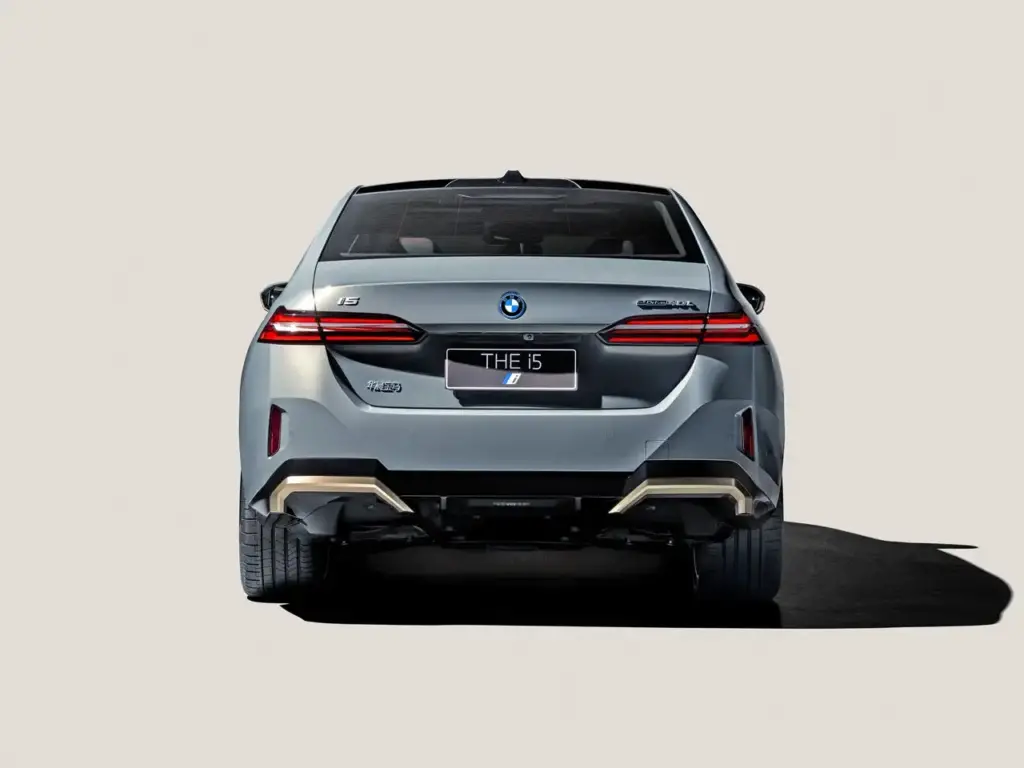
Exterior Design & Style
Signature BMW Styling Elements
The 2024 i5 features a sleek, aerodynamic sedan silhouette with proper sedan proportions rather than the coupe-like rooflines favored by some competitors. This conservative styling approach appeals to luxury sedan buyers who value familiar aesthetics over radical EV-specific designs[1].
BMW’s iconic kidney grille receives reimagined treatment for the i5, with a closed design optimized for aerodynamics while maintaining visual brand continuity. The long hood, short overhangs, and muscular character lines create the classic premium sedan look American buyers expect from BMW. Subtle, elegant exterior design with muted paint finishes creates sophisticated visual presence without ostentation.
Flush-fitting door handles improve aerodynamics while adding modern appeal. The handles automatically present themselves when the key fob is detected, retracting flush with the body when driving to minimize drag. Sharing design with the gas-powered 5 Series maintains visual continuity across BMW’s sedan lineup—a deliberate choice that distinguishes the i5 from more radical EV competitors.
Lighting & Visual Features
Angled adaptive LED headlights create a modern, aggressive front lighting design that gives the i5 distinctive nighttime presence. Sleek LED taillights at the rear complement the front lighting with elegant simplicity. The M60 trim features M Sport exterior design elements including aerodynamic enhancements, gloss-black Shadowline trim options, and optional rear lip spoiler for subtle performance cues[1].
The lighting design balances aesthetic appeal with functional excellence, providing excellent illumination for nighttime driving safety. Self-leveling capability maintains optimal beam pattern regardless of vehicle load, ensuring consistent road illumination whether driving solo or fully loaded with passengers and cargo.
Wheels & Tire Options
Wheel selection directly impacts range performance, with each inch increase in diameter reducing EPA estimates by approximately 10-15 miles. BMW offers three wheel size options across the i5 lineup[1]:
- 19-inch wheels: Standard on eDrive40, optimal for maximum range (295 miles EPA)
- 20-inch wheels: Optional on all trims, moderate range penalty (-10 miles approximately)
- 21-inch wheels: Available on all models, sportiest appearance (-17 miles range impact)
- M Aero wheel designs: Exclusive styling for M60 trim in 19-20-21 inch sizes
Buyers prioritizing maximum range should stick with 19-inch wheels unless visual preferences strongly favor larger diameter options. The difference between 19-inch and 21-inch wheels equals approximately 16 miles of range on the M60—meaningful for daily driving confidence and highway trip planning.
Available Exterior Colors
The 2024 color palette spans conservative to bold choices, with thirteen exterior color options including unique metallic and BMW Individual finishes[1]:
- Standard colors: Alpine White (no charge), Carbon Black Metallic
- Metallic finishes: Black Sapphire Metallic, Mineral White Metallic, Phytonic Blue Metallic, Sophisto Grey Metallic, Oxide Grey Metallic, Brooklyn Grey Metallic, Dark Graphite Metallic
- Premium/BMW Individual colors: Cape York Green Metallic, BMW Individual Tanzanite Blue II Metallic, BMW Individual Frozen Pure Grey, BMW Individual Frozen Deep Grey
The muted paint finishes with sophisticated look appeal to luxury sedan buyers who value understated elegance over attention-grabbing colors. BMW Individual options command premium prices but deliver exclusive finishes unavailable on mainstream models.
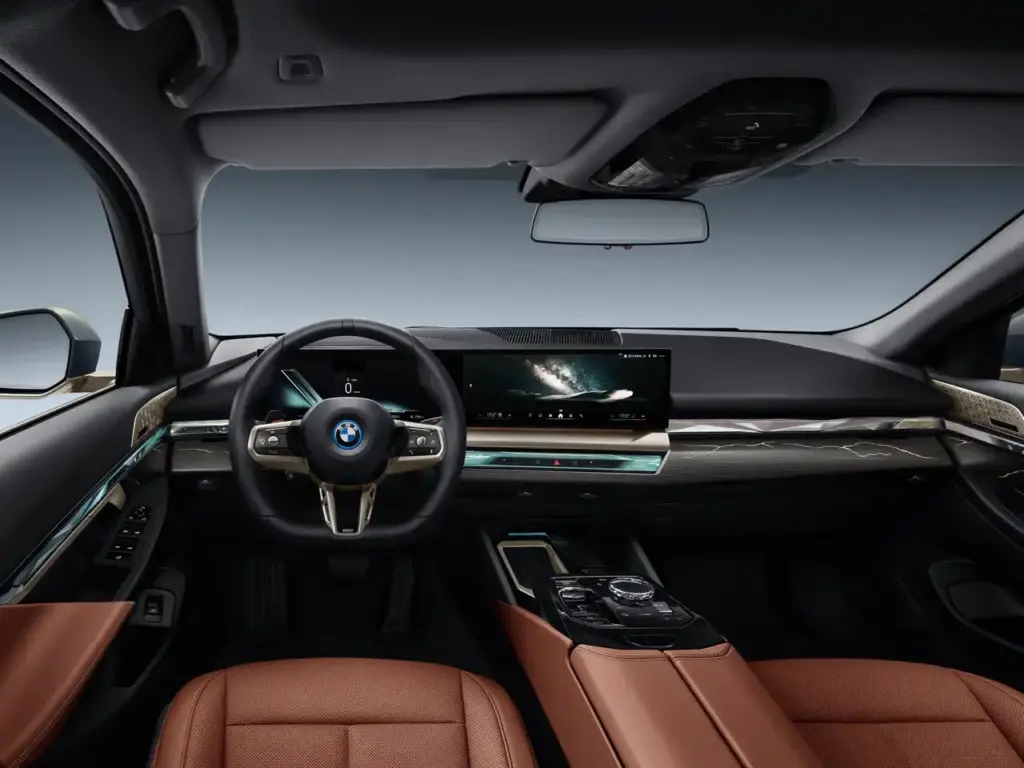
Interior Design & Comfort
Cabin Materials & Build Quality
The 2024 i5 interior represents what reviewers characterize as a “high-tech banquet for the eyes”—a luxurious, tech-filled cabin with premium finish throughout. The stylish and grown-up modern design draws strong influences from BMW’s higher-end 7 Series and 8 Series models[3].
Standard Veganza perforated synthetic leather upholstery provides premium feel while appealing to environmentally conscious buyers. The vegan leather mimics traditional leather’s appearance and texture surprisingly well. Optional Extended Merino leather ($2,450 upgrade) covers more interior surfaces with genuine leather for enhanced tactile luxury and softer hand feel[1].
Fine wood Dark Oak high-gloss trim with Dark Silver accent creates sophisticated ambiance. The exceptional standard of fit and finish demonstrates no penny-pinching on materials quality—even lower surfaces receive attention to detail that justifies the i5’s luxury positioning. Tight panel gaps and quality materials extending throughout the cabin compare favorably with the BMW 7 Series flagship sedan.
Seating Capacity & Space
The i5 accommodates five passengers with generous front and rear seating. Plenty of space exists for tall passengers, with adults up to 6’4″ fitting comfortably in front seats and adequately in rear seats[1]. Wide-opening doors facilitate easy entry and exit, particularly helpful when installing child seats or assisting elderly passengers.
However, a large central transmission tunnel—carried over from the gas 5 Series architecture—compromises middle rear seat comfort. This design element limits the i5’s advantage over dedicated EV platforms like the Mercedes EQE, which features a flat floor throughout. The 40/20/40 split fold-down rear seats add cargo flexibility for longer items like skis or lumber.
The M60 features upgraded seating with M Alcantara/Veganza upholstery, power multi-contour front seats including power backrest width adjustment and thigh support, and three-stage heated front seats for enhanced comfort[1].
Interior Color Schemes
BMW offers five interior color combinations for 2024, ranging from conservative to distinctive[1]:
- Black (standard Veganza)
- Black/Atlas Grey Extended Merino (premium leather upgrade)
- Burgundy quilted Veganza (select models)
- Various Extended Merino leather options
- M Alcantara/Veganza (M60 exclusive)
The color choices allow personalization without overwhelming buyers with excessive options. Most buyers gravitate toward Black or Black/Atlas Grey combinations, which provide timeless elegance that ages well and maximizes resale value.
Comfort & Convenience Features
Standard comfort features include four-way power lumbar support, two-way power glass moonroof with one-touch operation and sliding interior sunshade, and the BMW Interaction Bar with customizable ambient lighting creating unique visual atmosphere[1].
Additional comfort amenities:
- Cabin preconditioning via My BMW App (heat or cool before entering)
- Wireless device charging pad (accommodates largest smartphones)
- Optional heated and ventilated front seats with massage functions
- Glass Controls (optional, touch-sensitive surfaces)
- Sky Lounge Panoramic Roof with LED lighting patterns (optional, $2,500)
- My Modes system for customizable driving experiences (six profiles)
- Three-stage heated front seats (M60 standard)
The massage function offers multiple programs targeting different muscle groups—a genuine benefit on long drives rather than a gimmick. The My Modes system proves particularly useful, allowing drivers to tailor vehicle responses to specific situations: Personal for customized settings, Sport for dynamic driving, Efficient for maximum range, Expressive for engaging experience, Relax for comfort focus, and Digital Art for ambient lighting displays.
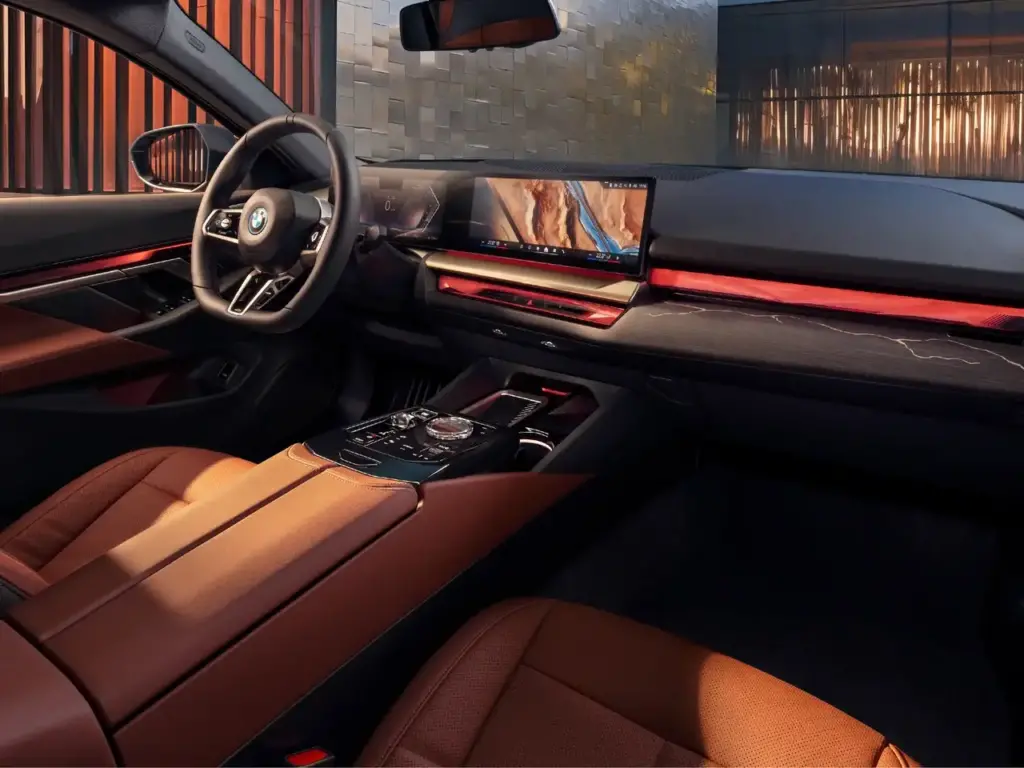
Technology & Infotainment
BMW Curved Display System
The centerpiece of the i5’s technology suite is the BMW Curved Display, featuring seamless integration of a 12.3-inch configurable digital instrument cluster with a 14.9-inch central information display. This curved design blends seamlessly with the dashboard, creating what some reviewers call a “heavily digital dashboard” that may not appeal to everyone[3].
The high-resolution displays provide intuitive control over navigation, entertainment, and vehicle settings, all enhanced by configurable display layouts. Drivers can emphasize navigation, audio, performance data, or EV-specific information like energy flow and charging status. High-resolution graphics render clearly even in direct sunlight, though some owners report the heavily digital interface requires adjustment for those preferring traditional analog gauges.
iDrive 8.5 Operating System
The 2024 i5 debuts BMW’s new iDrive 8.5 platform—a Linux-based operating system representing significant evolution from iDrive 8. This system features a fully revamped user interface with enhanced user experience, though some onscreen controls prove hard to learn or access initially[7].
Key iDrive 8.5 capabilities:
- Remote Software Upgrades via over-the-air updates (no dealer visits required)
- BMW Intelligent Personal Assistant responding to natural language voice commands
- 3D navigation with augmented reality overlays showing directional arrows
- Flexible touch widgets customizable for quick access to frequently used functions
- Multiple interaction methods: touchscreen, voice commands, gesture recognition, traditional iDrive controller
- Personalized user profiles storing individual preferences
The augmented reality navigation proves genuinely useful, superimposing directional arrows and helpful information directly onto the windshield view through the head-up display. However, reviews note there’s “more technology than most will ever use”—a common critique of modern luxury vehicles packed with features that go unexplored by average owners[3].
Connectivity & Smartphone Integration
Standard connectivity features include wireless Apple CarPlay and Android Auto compatibility, wireless device charging pad, and seamless smartphone integration. The AirConsole gaming system integration allows playing games on the BMW Curved Display using a smartphone as controller—a novelty feature for passengers during charging stops[1].
YouTube streaming capability functions while parked, providing entertainment during charging sessions. BMW Remote Services via the My BMW app enable owners to check charging status, pre-condition the cabin remotely, lock/unlock doors, and locate the vehicle from anywhere with cellular connectivity. Over-the-air update capability adds new features and improvements without requiring dealer visits, similar to smartphone software updates.
Audio & Entertainment
The Harman Kardon Premium Sound system comes standard on all 2024 i5 models, featuring 16 speakers delivering excellent sound quality with clear highs, warm mids, and surprising bass depth. The M60 upgrades to the Bowers & Wilkins Diamond Surround Sound system with 17 speakers including diamond dome tweeters and dedicated amplifier[1].
The Bowers & Wilkins system represents BMW’s top audio option, delivering concert hall-like sound staging and detail resolution that audiophiles appreciate. However, casual listeners may find the standard Harman Kardon system entirely satisfactory for daily use. Multiple sound profiles allow users to tailor audio characteristics to personal preferences or music genres.
Optional Tech Upgrades
Beyond standard equipment, BMW offers several technology enhancements worth considering for tech-savvy buyers[1]:
- Head-up display with augmented reality ($1,900): Projects navigation and vehicle information
- Highway Assistant (included in Driving Assistance Professional Package): Hands-free highway driving up to 85 mph
- Enhanced parking camera with 3D view: Bird’s-eye perspective for tight spaces
- Glass Controls: Touch-sensitive surfaces replacing physical buttons
- Digital Cockpit Professional: Enhanced graphics and additional display configurations
The Highway Assistant works smoothly with minimal corrections even in turns, though it requires drivers to pay attention and be ready to take over immediately. The system issues warnings after just five seconds of looking away, ensuring driver engagement[8].
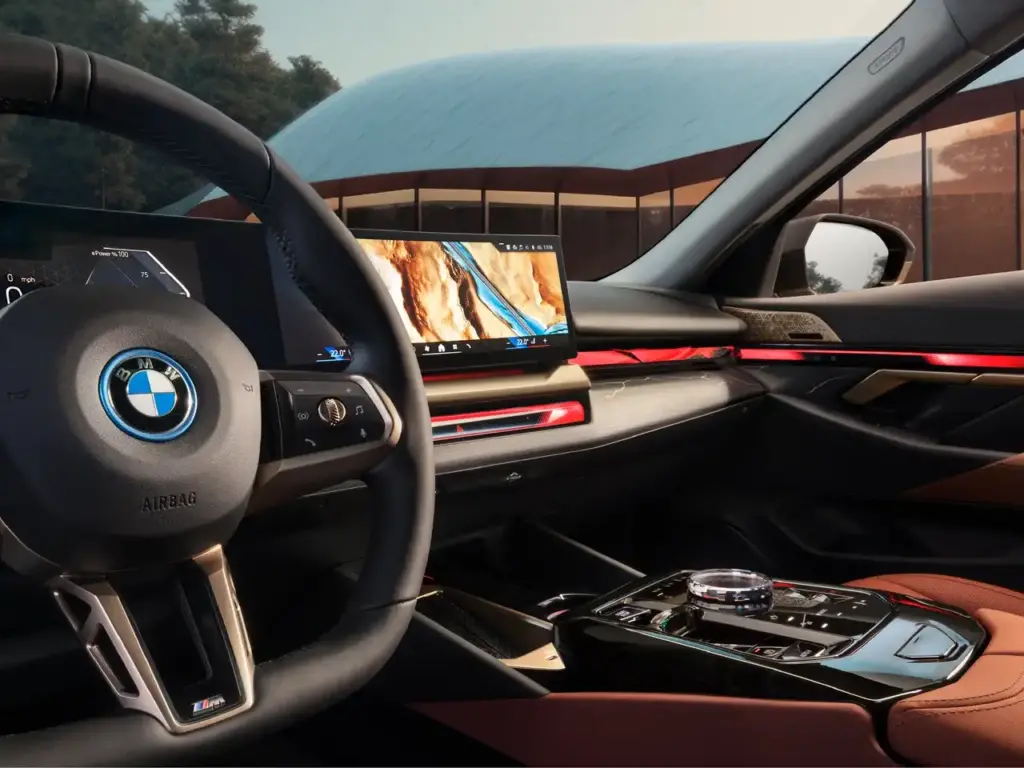
Safety & Driver Assistance
Standard Safety Features
BMW equips all 2024 i5 models with comprehensive active safety systems at no additional cost. These include forward-collision warning with intersection assist, automatic emergency braking, active blind spot detection (standard on all trims), rear cross-traffic warning with automatic braking, lane departure warning, and lane-keeping assist[9].
Additional standard safety equipment:
- Rain-sensing windshield wipers (automatic operation)
- Parking sensors front and rear
- Tire pressure monitoring system with individual wheel readouts
Surprising omission: Adaptive cruise control is NOT standard equipment—a notable gap given the i5’s luxury positioning and $66,800+ pricing. This feature requires the optional Driving Assistance Professional Package, an approach that surprises reviewers accustomed to adaptive cruise as standard on premium vehicles[3].
IIHS Safety Ratings & Crash Test Results
The 2024 BMW i5 has been evaluated by IIHS with strong results in front crash prevention testing with pedestrian detection. The system successfully avoided collisions in testing scenarios, demonstrating effective automatic emergency braking[9].
IIHS ratings summary:
- Front crash prevention (pedestrian): Strong performance
- Standard blind spot detection: Yes
- Standard lane departure warning: Yes
- Optional lane departure prevention: Available with Driving Assistance Professional
- Standard rear automatic braking: Yes
The related 2024 BMW 5 Series (which shares the i5’s platform) received Good ratings in side crash testing with excellent structural performance and occupant protection[9]. This suggests the i5 benefits from robust structural engineering despite lacking dedicated IIHS crash testing as of late 2024.
NHTSA ratings: As of September 2025, the 2024 BMW i5 has not yet received official crash test ratings from NHTSA. The vehicle remains too new for comprehensive federal testing to be completed and published.
Advanced Driver Assistance (Optional)
The optional Driving Assistance Professional Package adds BMW’s most advanced semi-autonomous capabilities at additional cost. Active Driving Assistant Pro provides partially automated driving with adaptive cruise control and lane-centering—features many competitors include as standard[8].
Package includes:
- Highway Assistant enabling hands-free driving on designated divided highways up to 85 mph
- Automatic lane changing around slower vehicles (tap turn signal to initiate)
- Parking Assistant Professional with automated parking
- 360-degree camera system providing bird’s-eye perspective
- Traffic jam assistant for bumper-to-bumper situations
Eye-activated lane changing—available initially in Germany, USA, and Canada—allows drivers to confirm lane changes by looking at side mirrors. However, this feature has not yet been fully deployed in the US market as of 2024[1].
Airbag & Structural Safety
The i5’s safety structure incorporates multiple airbags throughout the cabin, electronic stability control (ESC), ABS and driveline traction control, side impact beams, dual-stage driver and passenger airbags, high-strength chassis construction, and tire pressure monitoring system[1].
The battery pack mounting structure serves dual purposes—protecting the battery from intrusion while contributing to overall chassis rigidity. This design approach typifies modern EV safety philosophy, turning potential vulnerabilities into structural advantages.
Warranty coverage:
- 4 years/50,000 miles new vehicle limited warranty
- 8 years/100,000 miles battery warranty (typical for luxury EV segment)
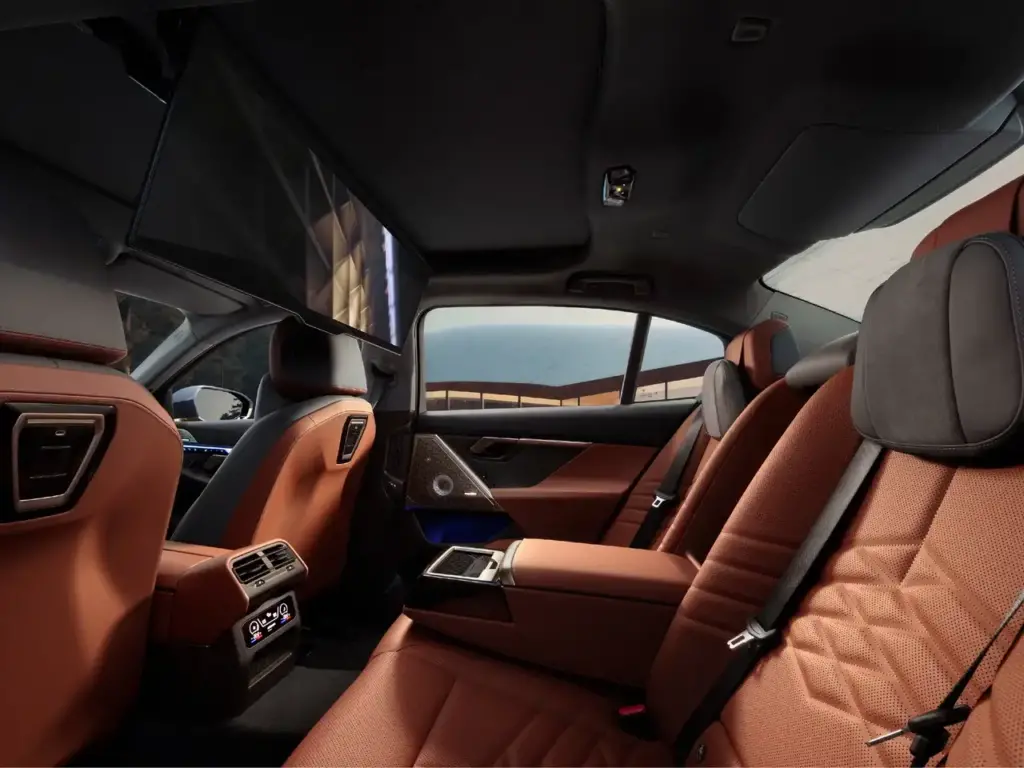
Cargo & Storage
Trunk Space Specifications
The 2024 i5 provides up to 17.3 cubic feet of rear cargo space—more than most EV rivals but less than the gas-powered 5 Series sedan due to battery placement under the rear floor[1]. The trunk opening is wide for easy loading, though there is no front trunk (frunk) like Tesla or dedicated EV platforms offer.
Pass-through capability exists via the 40/20/40 split fold-down rear seats for longer items like skis, lumber, or furniture. Underfloor storage compartments house the portable charging cable and provide secure storage for valuables. The cargo area proves adequate for weekly grocery runs, golf bags, or airport luggage for family vacations.
Interior Storage Solutions
Interior storage solutions include center console with armrest and storage, door pockets sized for water bottles and items, wireless charging pad for smartphones (occupies one phone position), cupholders in center console, various smaller storage compartments, and practical daily storage solutions[1].
The lack of a front trunk disappoints compared to Tesla Model S or dedicated EV platforms that offer additional luggage room under the bonnet. The front space houses electronic components and the front motor on M60 models rather than providing extra cargo capacity.
Practicality Considerations
The i5’s cargo limitations versus competitors like Tesla become apparent on family road trips or airport runs. Tesla’s clear advantage in total cargo space (frunk plus trunk) provides more flexibility for luggage, sports equipment, or Costco shopping trips. However, for daily driving and typical luxury sedan use cases, the i5’s 17.3 cubic feet proves adequate[1].
Child seat compatibility is excellent thanks to easy-access LATCH anchor points between the rear seat cushion and backrest. The spacious rear seat accommodates larger convertible child seats comfortably, and the wide-opening doors simplify installation of rear-facing seats—a meaningful consideration for families with young children.
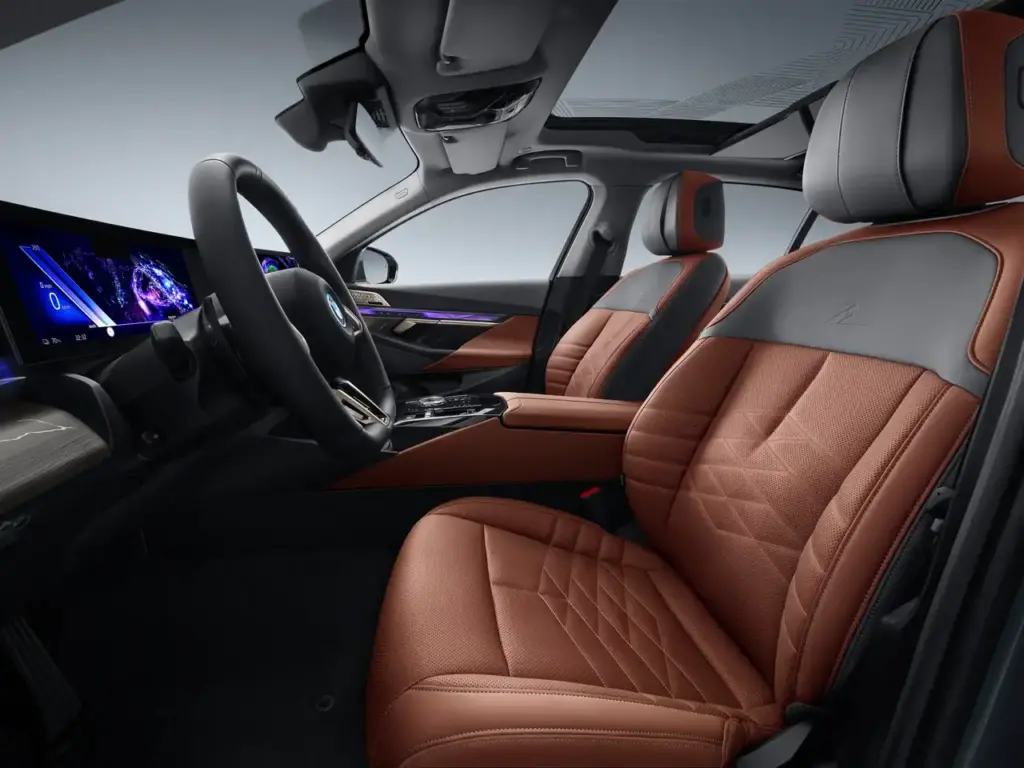
Ownership Experience & Real-World Use
Daily Driver Suitability
The 2024 BMW i5 excels as a daily driver, feeling faultless for typical commutes and errand running. Comfortable for 80 miles or less of daily driving, the quiet and comfortable operation makes it well-suited for both city traffic and highway cruising[3]. The instant electric torque provides effortless acceleration for merging and passing, while the smooth, composed ride quality enhances comfort over long distances.
Real-world owner experiences consistently praise the i5’s suitability for daily driving. Reviews characterize it as “fun to drive” with a “luxurious interior” that makes commuting genuinely enjoyable rather than merely tolerable. The range proves not an issue for daily commuting, with most owners charging overnight at home and starting each day with 80% charge (low 200s miles available).
Long road trip capability exists with proper charging planning. The included two years of complimentary Electrify America fast-charging facilitates longer journeys, though 30-minute charging stops every 200-240 miles require more planning than gas vehicles[6].
Charging & Range in Real-World Conditions
Home Level 2 charging installation represents a “must-have investment” for practical EV ownership convenience, typically costing $500-$2,000 depending on existing electrical capacity and distance from the main panel[6]. Most i5 owners install 40-50 amp circuits supporting 7.4-11 kW charging, enabling full overnight charging in 7-9 hours.
Public charging network experiences with Electrify America prove generally positive, though not without occasional frustrations. The i5 consistently achieves 180-205 kW peak rates when batteries are properly preconditioned. Real-world range of 240-300+ miles proves typical depending on trim, driving style, and conditions.
Cold weather range impacts are notable but manageable. Winter driving reduces range by approximately 20-25% in typical winter conditions (32-40°F), with extreme cold (-20°C to -15°C) reducing range by 30-35%. Highway versus city efficiency differences favor city driving where regenerative braking recaptures energy—highway cruising at 70-75 mph consumes more energy, typically reducing range by 10-15% compared to mixed city/suburban driving[4].
Maintenance & Ownership Costs
BMW covers the i5 with a 4-year/50,000-mile basic warranty and an 8-year/100,000-mile battery warranty. The battery coverage guarantees at least 70% capacity retention—typical for the industry and sufficient for most owners’ needs[1].
Maintenance costs for EVs are substantially lower than gas vehicles. There are no oil changes, transmission services, spark plug replacements, or complex engine maintenance. Brake longevity is extended significantly thanks to regenerative braking handling most deceleration, with brake pads often lasting 100,000+ miles.
Cabin air filter replacements, tire rotations, and coolant changes represent the primary scheduled maintenance. BMW estimates annual maintenance costs at $600-$800 versus $1,500-$2,000 for comparable gas models—a savings of approximately $900-$1,200 annually that accumulates to thousands over ownership.
Software updates and long-term reliability benefit from over-the-air (OTA) update capability. BMW can add new features and improve vehicle functions without requiring dealer visits, similar to smartphone software updates that happen seamlessly in the background.
Common Issues & Owner Feedback
While the i5 generally receives positive reviews, some owners report issues worth noting. Climate control failure appears in multiple owner forums, with reports of non-functional AC, dead rear controls, error messages, and unresponsive temperature controls[10][11].
Reported problems include:
- Climate control system malfunctions (error messages, unresponsive controls, AC failures)
- Electrical issues: 12V auxiliary battery problems affecting vehicle start
- Battery Control Module faults affecting charging cycles
- General electrical malfunction warnings on dashboard
- Start-stop system malfunctions
- Software and over-the-air update glitches requiring dealer intervention
- Some issues becoming more common after 150,000 km (93,000 miles)
The climate control issues often trace to loose cable connections or faulty wiring harness connections in the control module. Repairs typically require removing the center console to access wiring, cleaning connections, and securing everything properly—labor-intensive but usually effective[11].
Infotainment complexity represents another common owner complaint. The learning curve for iDrive 8.5 can be steep, with some owners noting there’s “more technology than most will ever use.” However, generally positive reviews despite these minor issues suggest most owners successfully adapt and enjoy their vehicles[3].
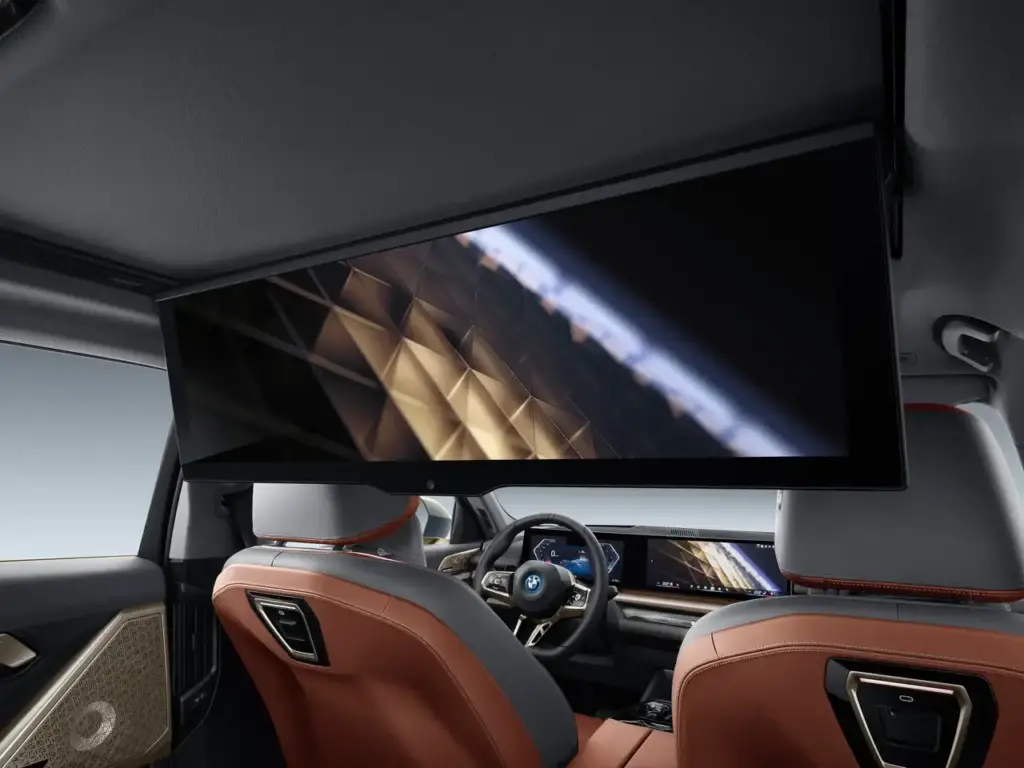
Competitive Comparison & Alternatives
BMW i5 vs Mercedes-Benz EQE
The Mercedes-Benz EQE 350+ starts at $77,900 with 288 horsepower—$11,100 more than the i5 eDrive40’s $66,800 price for 335 horsepower. This pricing disadvantage represents Mercedes’ biggest challenge against the BMW[12].
| Specification | BMW i5 eDrive40 | Mercedes EQE 350+ | Advantage |
|---|---|---|---|
| Starting Price | $66,800 | $77,900 | BMW by $11,100 |
| Horsepower | 335 hp | 288 hp | BMW by 47 hp |
| EPA Range | 270-295 miles | 305 miles | Mercedes by 10-35 miles |
| Real-World Range | 300+ miles (tested) | Not extensively tested | Likely BMW |
| Driving Experience | More engaging | More isolated | BMW preference |
| Interior Technology | More user-friendly | More complex | BMW preference |
The i5 offers more engaging driving experience and better value at a lower price point. The EQE’s dedicated EV platform provides a flat floor throughout the cabin, eliminating the i5’s central transmission tunnel that compromises middle rear seat comfort. However, for most buyers, the i5’s superior driving dynamics, $11,100 price advantage, and more user-friendly interior technology make it the better choice[12].
BMW i5 vs Tesla Model S
The Tesla Model S starts at $74,990 with 670 horsepower and 405 miles of EPA range—substantially more than the i5’s 295 miles maximum. Tesla’s Supercharger network provides faster, more convenient charging infrastructure throughout the United States[1].
| Specification | BMW i5 eDrive40 | Tesla Model S | Advantage |
|---|---|---|---|
| Starting Price | $66,800 | $74,990 | BMW by $8,190 |
| Horsepower | 335 hp | 670 hp | Tesla by 335 hp |
| EPA Range | 270-295 miles | 405 miles | Tesla by 110-135 miles |
| Efficiency | 105 MPGe | 127/116 MPGe | Tesla better |
| Cargo Space | 17.3 cu ft | 28 cu ft + frunk | Tesla significantly more |
| Interior Materials | Premium leather/Veganza | Synthetic leather | BMW better quality |
| Charging Network | Electrify America (CCS) | Supercharger | Tesla advantage |
Tesla offers superior battery technology, significantly more range, and the Supercharger network advantage. However, the BMW provides affordability ($8,190 lower starting price), traditional luxury sedan refinement, better interior materials and build quality, and the BMW brand experience that resonates with traditional luxury sedan buyers[1].
For buyers prioritizing traditional automotive luxury with electric efficiency, the i5 represents the sweet spot. Tesla buyers prioritize technology, range, and the Supercharger network over conventional luxury appointments and brand heritage.
BMW i5 vs Porsche Taycan
The Porsche Taycan starts above $90,000, offering superior handling and sportiness thanks to its lower center of gravity and sport-focused suspension tuning. The Taycan’s 800V electrical architecture enables significantly faster charging—270 kW peak versus the i5’s 205 kW[1].
However, the i5 offers better everyday livability and practicality. The Taycan prioritizes performance over comfort, with a firmer ride and more aggressive seating position. For performance enthusiasts willing to pay premium prices, the Taycan delivers. For buyers seeking balanced luxury and usability, the i5 provides better value at a $24,000+ lower price point.
BMW i5 vs Genesis Electrified G80
The Genesis Electrified G80 offers strong value proposition with similar luxury features at a potentially lower price than the i5. Genesis includes generous standard equipment and longer warranty coverage (10 years/100,000 miles on battery versus BMW’s 8 years/100,000 miles)[1].
The i5 counters with BMW brand prestige, more extensive dealer network coverage for service accessibility, and superior driving dynamics. Technology and feature parity exists between the models, making the choice primarily about brand preference, dealer accessibility, and budget considerations.
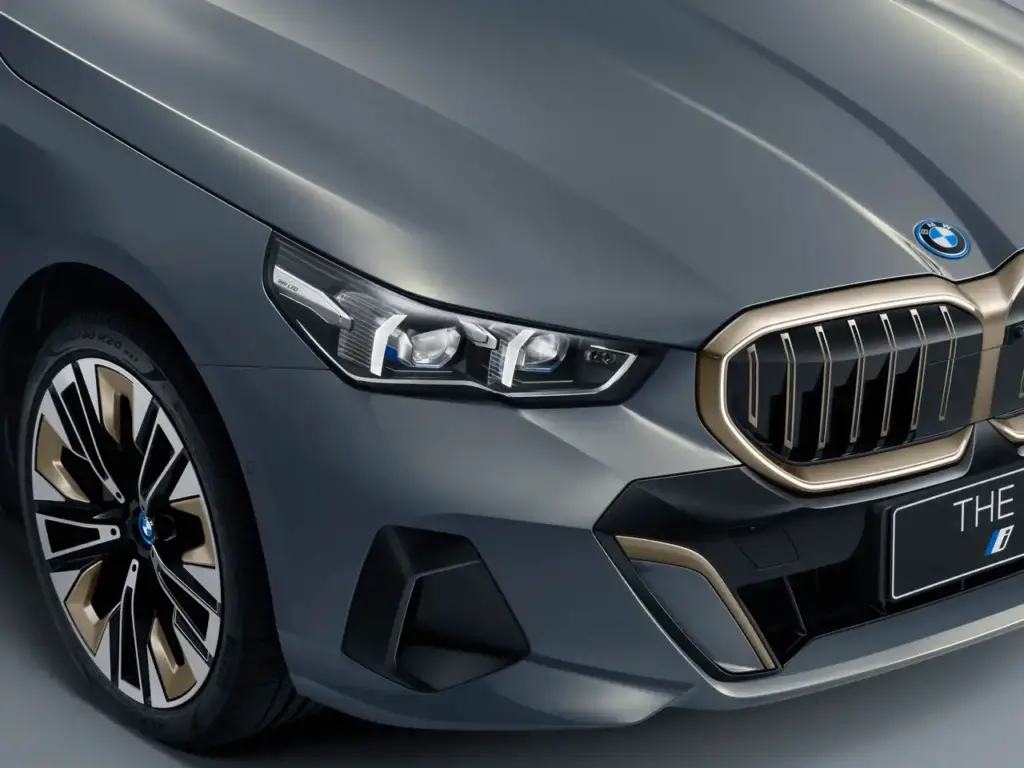
Pros & Cons Summary
Key Advantages
The 2024 BMW i5 excels in several critical areas that matter to American luxury sedan buyers[1][3][4]:
- Impressive performance across both trims (3.3-5.7 seconds 0-60 mph)
- Luxurious, tech-filled interior with premium materials and exceptional fit/finish
- Comfortable and classy cabin design drawing from BMW’s higher-end models
- Advanced technology features including Interaction Bar and My Modes system
- Excellent real-world range exceeding 300 miles in Edmunds testing
- Lots of standard in-car tech features without excessive option packages
- More cargo space than most EV rivals (17.3 cubic feet)
- Comfortable and quiet ride quality with serene cabin
- Balanced and stable handling maintaining composure through corners
- Excellent build quality with no penny-pinching on materials
- Athletic electric sedan with refined ride balancing sport and comfort
- One of best-rounded electric sedans available in US market
- Two years free Electrify America charging ($1,500-$2,000 value)
Notable Drawbacks
No vehicle is perfect, and the i5 has limitations worth considering[1][3][6][10]:
- High cost for luxury EV segment ($66,800-$84,100)
- Significant vehicle weight (4,916-5,247 lbs) affecting ultimate dynamics
- Heavy EV impacts handling compared to lighter sports sedans
- Less trunk space than gas 5 Series sedan
- Some onscreen controls hard to learn or access initially
- Heavily digital dashboard may not appeal to traditional gauge enthusiasts
- More technology than most will ever use (complexity concerns)
- Adaptive cruise control NOT standard (surprising luxury vehicle omission)
- Range not class-leading versus Tesla Model S (295 vs 405 miles)
- Not eligible for federal EV tax credit (purchase customers)
- Climate control and electrical issues reported by some owners
- 12V auxiliary battery problems in some cases
- Large central transmission tunnel compromises middle rear seat
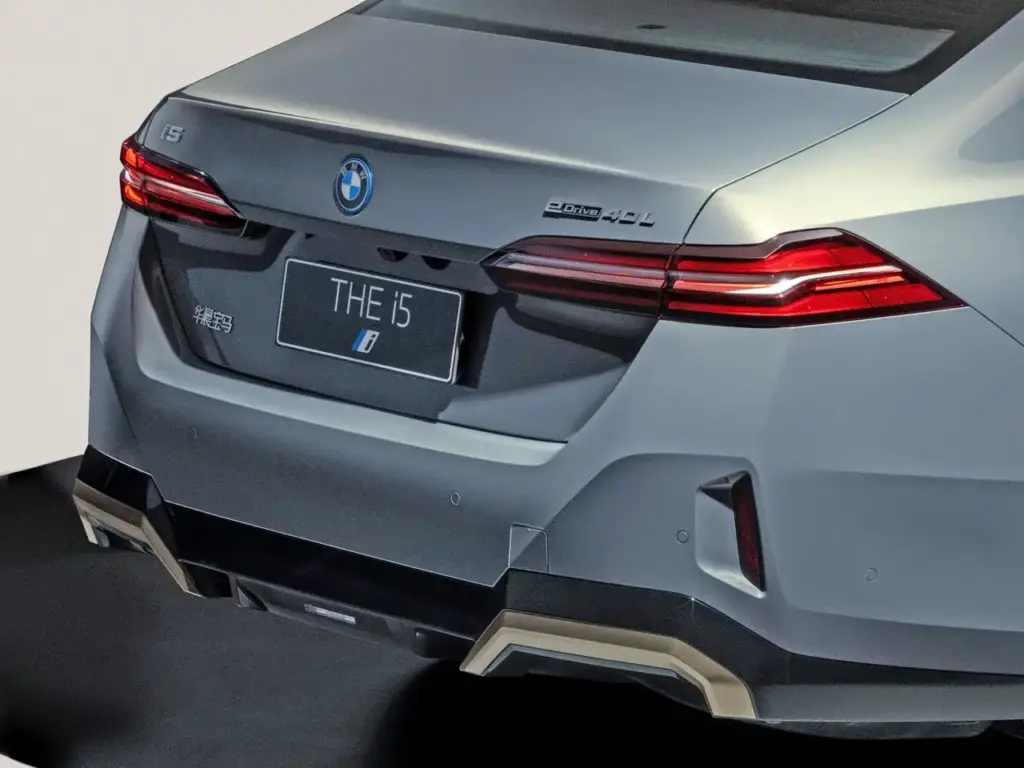
Final Verdict: Is the 2024 BMW i5 Worth the Cost?
Best For
The 2024 BMW i5 particularly suits several buyer profiles who value balanced capabilities over single standout specifications[1][3][4]:
- BMW enthusiasts making the EV transition who want familiar driving dynamics
- Luxury sedan buyers wanting athletic EV with refined ride quality
- Daily commuters covering 80 miles or less with home Level 2 charging access
- Tech-savvy drivers appreciating cutting-edge infotainment features
- Buyers prioritizing comfort and driving dynamics over maximum range figures
- Those wanting traditional BMW brand experience in electric format
- Drivers valuing balanced performance and luxury refinement
Consider Alternatives If
Certain buyer priorities point toward competitors offering different strengths:
- Maximum range is top priority: Choose Tesla Model S (405 miles EPA)
- Budget-conscious EV shopping: Consider alternatives with lower entry prices
- Want fastest charging speeds: Explore 800V competitors like Porsche Taycan
- Need most advanced automation: Tesla Autopilot offers more capability
- Prioritizing cargo space over luxury: Tesla Model S or SUV alternatives
Overall Rating & Recommendation
According to Autvex automotive experts and industry reviews, the 2024 BMW i5 earns strong marks across evaluation criteria[1][3]:
| Category | Rating | Commentary |
|---|---|---|
| Performance | 9/10 | Excellent acceleration across trims; M60 delivers genuine thrills |
| Interior | 9/10 | Luxurious materials, high-tech features; central tunnel compromises rear |
| Technology | 8.5/10 | Comprehensive features with learning curve for complexity |
| Comfort | 9/10 | Excellent ride quality and serene, quiet cabin |
| Value | 7/10 | Competitive pricing but lacks federal tax credit |
| Range | 7.5/10 | Good real-world performance but not class-leading |
| Overall Score | 8.3/10 | Strong buy for luxury EV sedan segment |
The 2024 BMW i5 represents a mature, well-executed electric luxury sedan that earned Editors’ Choice recognition and PCMag’s “best high-end sedan on the EV market” designation. It doesn’t chase headline numbers like 500-mile range or sub-3-second acceleration in base trims, instead focusing on delivering a well-rounded package that satisfies real-world needs[3].
For buyers seeking a premium electric sedan that drives like a BMW while offering excellent range and modern technology, the 2024 i5 delivers convincingly. The lack of federal tax credit eligibility represents a $7,500 disadvantage for purchase customers, though lease options can capture equivalent incentives.
Anyone considering the i5 should test drive it alongside the Mercedes EQE and Tesla Model S to experience the differences firsthand. The BMW’s driving dynamics, interior quality, and real-world range typically win over cross-shoppers who value traditional luxury sedan attributes over maximum specifications. The 2025 BMW i5 continues the formula with refinements, but the 2024 model year represents BMW’s strong electric sedan debut.
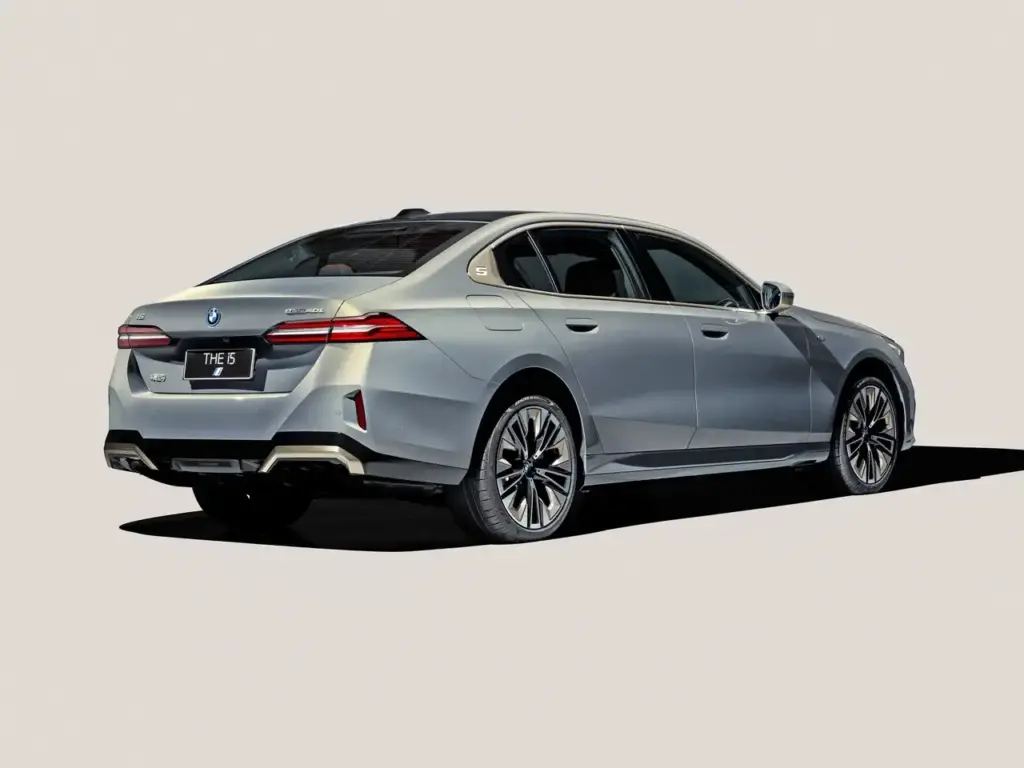
Key Takeaways
- The 2024 BMW i5 achieves 300+ miles real-world range, exceeding EPA estimates by 10-19% in independent testing.
- Two trim levels from $66,800-$84,100 offer 335-593 horsepower with balanced performance and luxury refinement.
- Standard features include BMW Curved Display, Harman Kardon audio, and comprehensive safety systems without option packages.
- Federal EV tax credits do NOT apply to i5 purchases, creating $7,500 disadvantage versus qualifying competitors.
- Real-world efficiency of 105/85 MPGe significantly outperforms Mercedes EQE and provides excellent daily driving range.
- The i5 excels as daily driver for 80-mile commutes with quiet operation and comfortable ride quality.
- Buyers prioritizing traditional luxury sedan refinement over maximum range will find the i5 most satisfying choice.
FAQs
What is the range of the 2024 BMW i5?
The 2024 BMW i5 eDrive40 achieves 270-295 miles EPA estimated range depending on wheel size. Independent Edmunds testing achieved over 300 miles on a single charge. The M60 offers 240-256 miles EPA, with 264 miles achieved in testing with 21-inch wheels[2].
How much does the 2024 BMW i5 cost?
Pricing starts at $66,800-$67,795 for the eDrive40 and $84,100-$85,095 for the M60. The i5 undercuts the Mercedes-Benz EQE by $11,100 while delivering more power. Options and destination charges add to base prices[1].
How long does it take to charge a 2024 BMW i5?
DC fast-charging from 10-80% takes approximately 30 minutes at 205 kW peak rates. Home Level 2 charging completes a full charge in 8 hours. Ten minutes of DC fast-charging adds 90-100 miles of range[1].
Is the 2024 BMW i5 eligible for federal tax credit?
No, the 2024 BMW i5 is NOT eligible for the $7,500 federal EV tax credit for outright purchases due to foreign assembly and battery sourcing. However, lease customers can access equivalent incentives through BMW Financial Services as capitalized cost reductions[5].
What’s the difference between i5 eDrive40 and M60?
The eDrive40 uses a single 335-horsepower rear motor with rear-wheel drive and 270-295 miles range. The M60 adds a front motor for 593 horsepower, all-wheel drive, 240-256 miles range, and M Sport features for $17,300 more[1].
Does the BMW i5 have a frunk (front trunk)?
No, the 2024 BMW i5 does not have a front trunk. The space under the hood houses electronic components and the front motor on M60 models. Cargo storage is limited to the 17.3 cubic foot rear trunk[1].
How does the 2024 BMW i5 compare to Tesla Model S?
The Tesla Model S offers more range (405 miles), faster charging via Supercharger network, and more cargo space. The BMW i5 provides superior interior quality, traditional luxury sedan refinement, and BMW driving dynamics at $8,190 lower starting price ($66,800 vs $74,990)[1].
Is the BMW i5 M60 worth the extra cost?
The M60’s $84,100 price ($17,300 premium over eDrive40) brings 593 horsepower, 3.3-second 0-60 mph times, adaptive M suspension, and Bowers & Wilkins audio. It’s worth it for performance enthusiasts but unnecessary for most buyers who’ll find the eDrive40 entirely satisfying[4].
What are common problems with the 2024 BMW i5?
Owner reports cite climate control system failures (non-functional AC, error messages), 12V auxiliary battery problems affecting vehicle start, Battery Control Module faults affecting charging, electrical malfunction warnings, start-stop system issues, and software glitches. Most issues are addressable through dealer service[10][11].
Is the 2024 BMW i5 good as a daily driver?
Yes, the 2024 BMW i5 excels as a daily driver, feeling faultless for commutes up to 80 miles. Quiet, comfortable operation, excellent real-world range exceeding EPA estimates, and accurate range prediction make it suitable for daily use. Range is not an issue for typical commuting[3].
How much cargo space does the 2024 BMW i5 have?
The BMW i5 provides 17.3 cubic feet of trunk capacity—more than most EV rivals but less than the gas 5 Series sedan. It lacks a front trunk unlike Tesla Model S. Pass-through rear seats accommodate longer items[1].
Does the 2024 BMW i5 come with free charging?
Yes, BMW includes two years of complimentary Electrify America DC fast-charging with 30-minute sessions at the nation’s most extensive CCS charging network. This benefit represents $1,500-$2,000 value for moderate users and eliminates charging costs during early ownership[1].
References
- Car and Driver. (2024). “2024 BMW i5 Review, Pricing, and Specs.” https://www.caranddriver.com/bmw/i5-2024
- Edmunds. (2024). “Our 2024 BMW i5 M60 Crushed Its EPA Range Estimate.” https://www.edmunds.com/car-news/2024-bmw-i5-m60-range-tested-long-term-update.html
- PCMag. (2024). “2024 BMW i5 Review.” https://www.pcmag.com/reviews/2024-bmw-i5
- Car and Driver. (2024). “2024 BMW i5 eDrive40 Tested: Great 5er, Great EV.” https://www.caranddriver.com/reviews/a60990560/2024-bmw-i5-edrive40-test/
- BMW of South Austin. (2024). “2024 BMW EV Tax Credit: What Texas Buyers Need to Know.” https://www.bmwofsouthaustin.com/blog/2024/september/3/2024-bmw-ev-tax-credit.htm
- Edmunds. (2024). “Our 2024 BMW i5 M60 Needs One Thing to Make It Great.” https://www.edmunds.com/car-news/2024-bmw-i5-more-range-long-term-update.html
- BMW of Bridgewater. (2024). “Exploring BMW iDrive 8.5 Infotainment System.” https://www.bmwofbridgewater.com/blog/navigating-the-future-exploring-bmw-idrive-8-5-infotainment-system
- Capital One. (2023). “2024 BMW i5 Review and Test Drive.” https://www.capitalone.com/cars/learn/finding-the-right-car/2024-bmw-i5-review-and-test-drive/2770
- IIHS. (2024). “2024 BMW i5 Safety Ratings.” https://www.iihs.org/ratings/vehicle/bmw/i5-4-door-sedan/2024
- MyCarly. (2024). “BMW i5 Climate Control Failure Frustrates Owner.” https://www.mycarly.com/community/bmw-i5-climate-control-failure-frustrates-owner-f0bd82d6-bae2-40a0-9079-8b739f6b7875/
- MyCarly. (2024). “BMW i5 Climate Control Nightmare: Dead AC and Error Codes.” https://www.mycarly.com/community/bmw-i5-climate-control-nightmare:-dead-ac-and-error-codes-b3295320-6310-4731-8535-1f4bc18ad42e/
- BMW Blog. (2024). “BMW i5 vs Tesla Model S and Mercedes-Benz EQE.” https://www.bmwblog.com/2024/01/14/bmw-i5-vs-tesla-model-s-and-mercedes-benz-eqe/

I am a senior automotive analyst at Autvex. Expert vehicle evaluations, in-depth reviews, and objective analysis helping readers make informed automotive decisions with years of industry experience.

